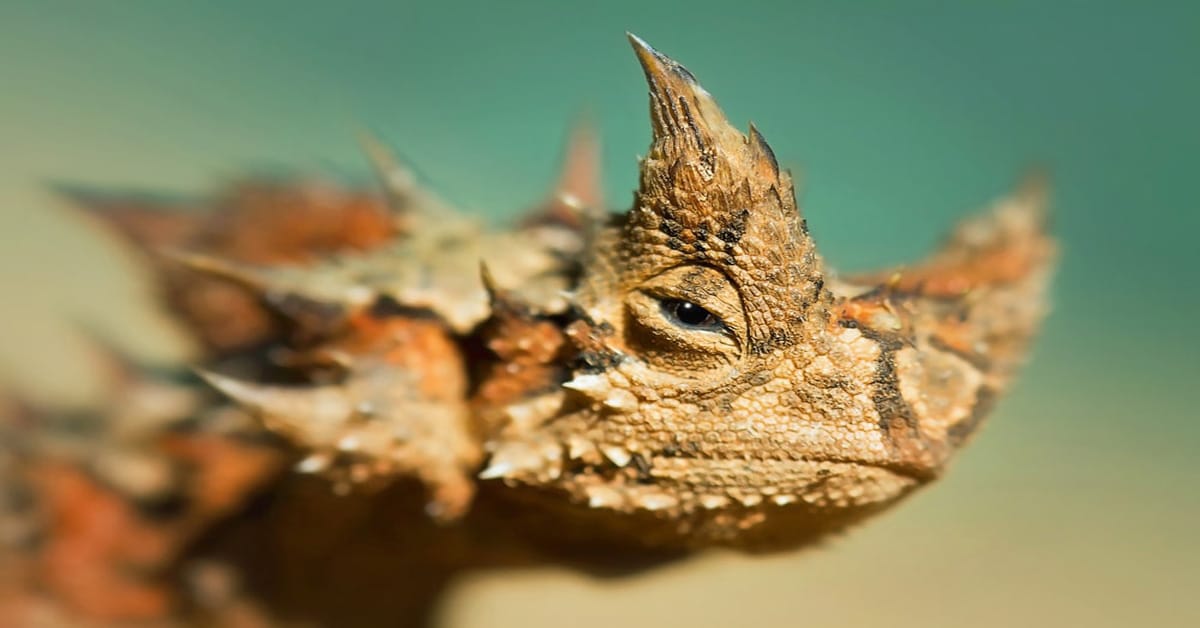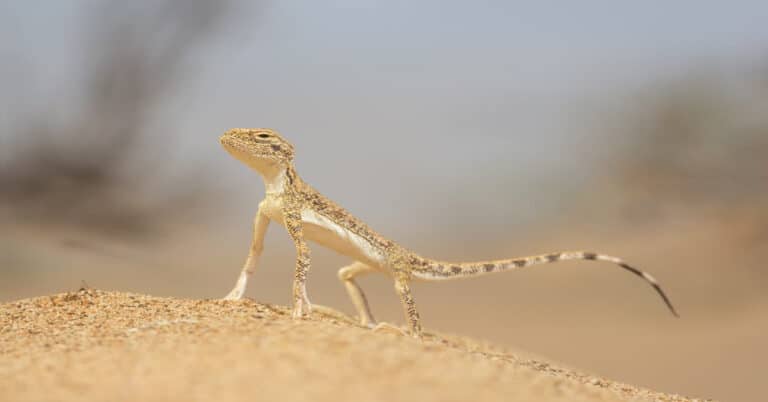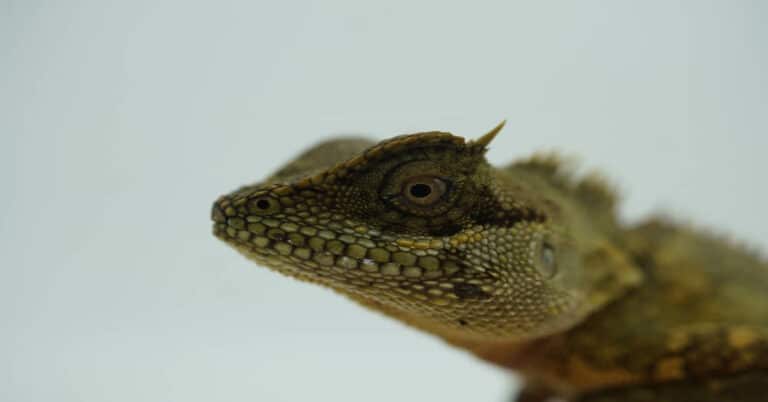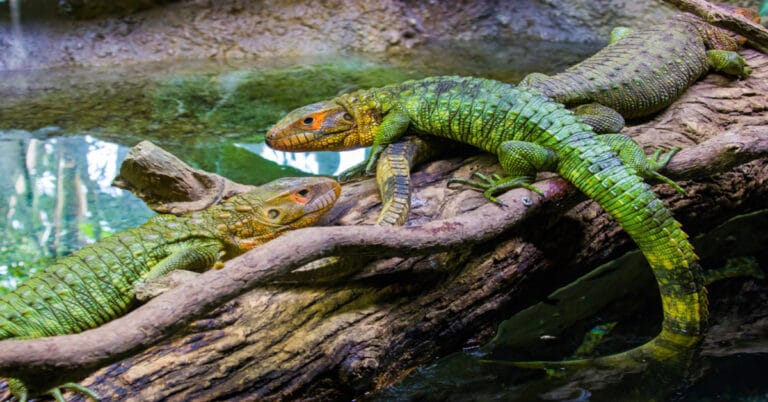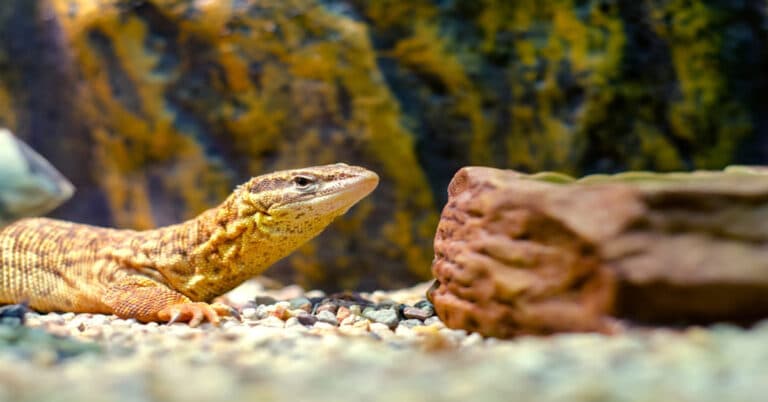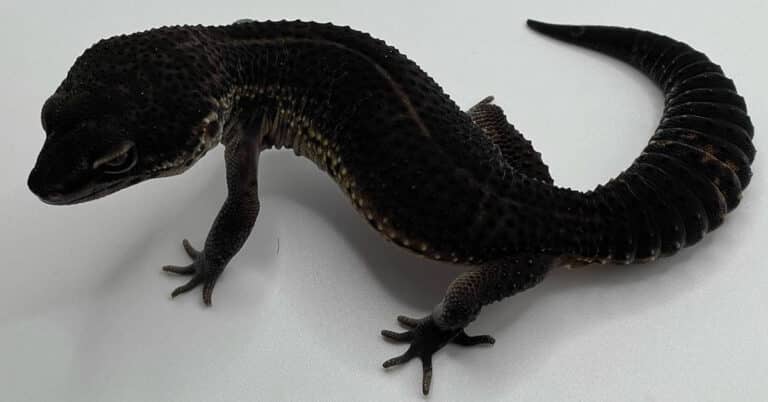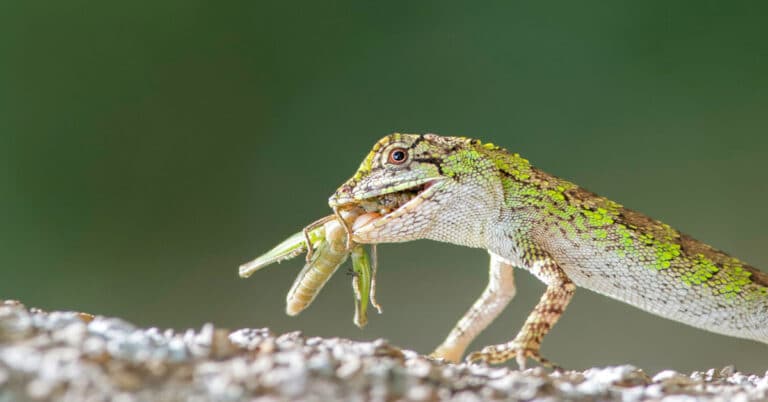Weird Lizards (A Compilation)
Thorny Mountain Devil Lizard (Moloch horridus)
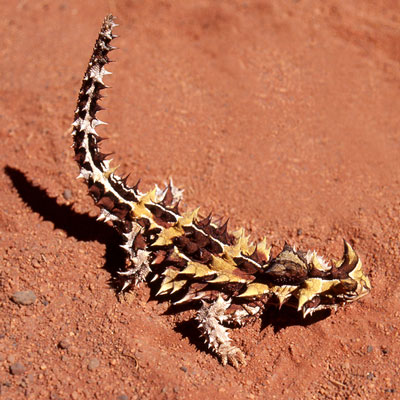
The thorny dragon a k a thorny devil belongs to the species Moloch horridus. This is basically Australian in origin. They call this lizard by many names. The thorny devil, Thorny lizard, the Moloch, and Mountain devil are a few of them. This is the one and only species of the genus Moloch. Thorny devil grows to a length of 20 centimeters or eight inches. It has a lifespan of around 20 years. Many of these lizards have the natural camouflage of the shades of tans and desert browns. The pale colors that they sport in warm weather change to darker colors in cold weather. Thorny, mostly non-calcified spines cover these animals almost entirely.
Anatomy
Fierce looking spikes cover the upper side of the thorny devil’s body. The thorny scales work as a defense against predators. The other modes of the defenses of the thorny lizard against predators are camouflage and deception. The lizard has an unusual way of moving around. It goes through the motions of freezing and rocking as it moves in search of water, food and mates.
Behavior
The sharp, spine-covered body of the thorny devil discourages attacks by predators by making it impossible for them to to swallow it The thorny devil has another peculiar defense system. It is in the form of a false head on its back. When a predator threatens it, it just lowers its head between the front legs and presents its pseudo- head to its enemies.
Habitat
Thorny devils live in desert areas and arid scrub lands that lie spread over most of central Australia. For instance, we can find them in the Sandridge desert areas, Spinfex sand-plains and areas that comprise the Mallee belt.
You would do better to associate the habitations of the thorny devils to coincide more with the areas with Sandy loam soils than regions with a particular climate in western Australia.
As a Pet
Breeding
The mating season of the thorny lizard is through late winter to the onset of summer.
Housing
You must house the lizards in aquariums large enough to accommodate their free movement. You should create artificial sand dunes and plant some thorny bushes for them to get the natural feel of the lizards’ original natural environments. You should also maintain dry temperatures like their natural habitats.
Food
Ants are the staple food of the thorny lizards. In fact, the lizard consumes thousands of ants in a day. The moisture they need, they get from the condensation of dew on their bodies at night. The dew that forms on the skin enters into the lizard’s mouth through the hygroscopic grooves situated between the spines.
Handling
Thorny devils do not need much care or attention from you. They are not used to handling. Then there is the chance of your hands getting pricked by their spines.
Spiderman Lizard (Agama Mwanzae)
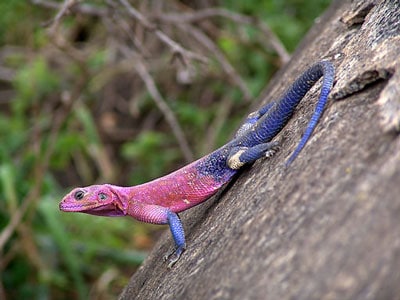
The redheaded Rock Agama belongs to the species Agama Mwanzae ,. This lizard is native to East Africa. This lizard is fascinating as well as unique among Sgamid lizards. The more than 350 species in the family live in cluster groups. These lizards are cold-blooded and grouping may help them to retain heat during cool nights. They seem to believe in the safety of numbers. Predators will certainly find it hard to pick out individuals in a group.
Anatomy
Their short bodies, long limbs and toes enable them to climb vertical walls easily.
Habitat
Rock Agamas are confined to East Africa. You can observe these lizards that people also call Mwanzaeflat Headed Agamas on the rocky outcrops. They often seek shelter in the gaps between large boulders. In areas with human habitation, they exhibit the tendency to hide in the cracks of mud walls and iron roofs.
Oriental Garden Lizard (Calotes versicolor)
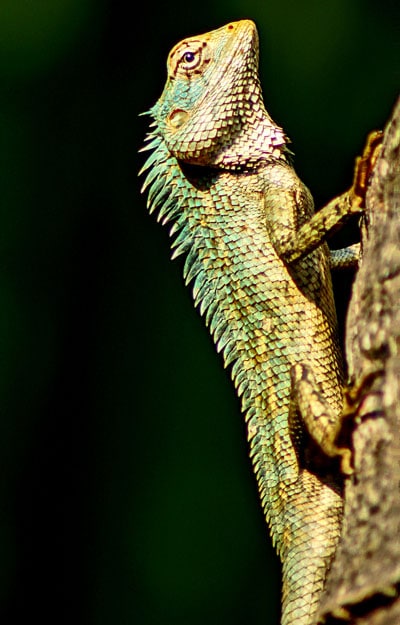
Oriental garden lizards are called many names. Eastern garden lizards and changeable lizards are their other names. They belong to the species Calotes versicolor. They are agamid lizards. We can find them widely distributed in Asia. People have introduced them in many other parts of the world. Eastern garden lizards are insectivores. The males sport a bright red color on their throats during mating season. This has earned them the inapt sobriquet “Blood Suckers”.
Anatomy
The body length of the garden lizard is only a little over 10 cms. But the length, including the tail is around 37 cms or 14,5 inches. There are two groups of spines, very small and clearly separated from each other, over each tympanum. You can find the dorsal crest slightly elevated on the neck and the front portion of the trunk. This extends to the tail’s root in the large lizards. In the younger ones, they gradually seem to disappear in the trunk’s mid portions.
Habitat
The habitats of the oriental lizards range from south east Iran to India, including Pakistan, Afghanistan, Nepal and Bhutan. They are very common in the Indian mainland and the Andaman islands, Srilanka, Thailand, Myanmar, Maldives and western Malaysia, Cambodia, Vietnam, Indonesia, Mauritius and parts of south China are the other areas where you can see these species. People have introduced these lizards to Singapore, Oman and the U.S.
As A Pet
Breeding
A lot of changes happen to the male in breeding season. They become strongly territorial in nature and develop orange or crimson colors on the head and neck. The lizard inflates its throat dewlap , turns sideways and seriously starts bobbing its head up and down. Their color changes to a pale yellowish hue and there appears a striking black patch on each side of their throats. Females and males venture close together, with the male religiously keeping up the head bobbing, till they get close enough to mate. The sexual act lasts around two minutes.
Housing
Because these lizards are very active, the smallest accommodation you can provide for them would be a 50 Gallon tank. You should use tree bark as substrate. You can use tap water, distill water or Mineral water. Make sure that you change the water every day.
Food
These changeable lizards are basically carnivores. They eat small vertebrates which include rodents and other lizards as well as insects. Their teeth grip the prey, but will not tear them up/ After stunning the prey by shaking it it around, they swallow it whole. Sometimes, the younger lizards, because of their inexperience, try to consume more than they are able to swallow, with predictable results. If the situation demands, these changeable lizards will eat vegetable matter as well.
The Mexican mole lizard (Bipes Biporus)
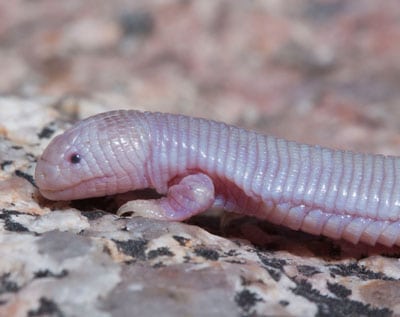
Meet the most strange members of lizard kind, Mexican Mole lizards. Many scientists consider that the strange creatures are the elusive missing link between the snakes and lizards. The Mexican mole lizards are generally called five-toed worm lizards, Bipes or Ajolotes. This lizard is amphisbaenian, a species endemic to Mexico’s Baja California. Only four species of amphisbaenians have legs and the mole lizard is one of them. Like all amphisbaenians, these burrowing species surface only at night or after very heavy rains.
Anatomy
“Bipes’ are reptiles. They are lizard-like creatures. The snout-to-vent length is around 18 to 24 centimeters. The average lifespan is around a couple of years. The closely segmented skin gives the Mexican mole, a corrugated look. The underground is peristaltic like the earthworms. They have strong, paddle-like forelegs. They have no hind legs to speak of, only vestigial bones. Their toes function as claws for digging. They usually remain just below the surface. They do go deeper when the temperature soars. This is bound to happen often since this species is endemic to Mexico. The Mexican mole looks just like one long tail. In fact, the tail is only 10% of its length. The tail is so stubby that you can easily mistake it for the mole’s head.
Breeding
Mexican mole lizards are egg layers. The species only breeds underground. They also mate in their burrows. The females lay 1-4 eggs in July, a very dry time of the year. The eggs are ready to hatch when the rains arrive.
Food
The Mexican mole lizards are carnivores. They are real opportunists that eat almost anything they can catch, including termites, ants, larvae, ground dwelling insects, earthworms and small animals, which include lizards. They, as a rule, pull the prey down on the ground before commencing on their meal.
Philippine Sailfin Dragon (Hydrosaurus Pustulatus)
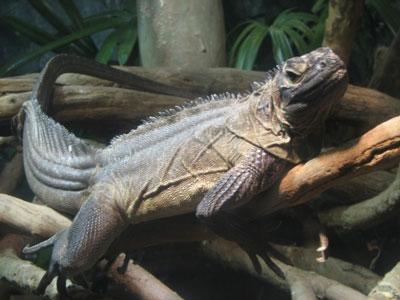
Sailfin dragons belong to the species Hydrosaurus pustulatus, H. Amboinensis and H. ”weberi” . They are large-bodied lizards hailing from the tropical areas of East Indonesia, the Phillippines and New Guinea. These are the largest members of the agamid family. These lizards are real water-lovers. You can usually spot them enjoying the sunlight near mountain streams. At the first sight of danger, they take off into the water on two legs until they sink and then, swim away. They have the ability to remain underwater up to an hour till the threat passes. The sailfin lizard is an excellent swimmer and uses its flattened toes to run across water. This species is omnivorous. They feed on leaves, fruits, flowers, insects or even small animals. They live close to the rivers in Philippine’s tropical forests. The males sport larger crests than the females on their backs. The males also exhibit a violet color when they grow older. The females appear little shabby in comparison.
Anatomy
The sailfin lizards need a lot of room.. They measure about 3 feet in length in captivity. Large adults of the species, grow up to 4 feet long. Females are usually a third of the size of the males.
Indonesian giants and Phillipine Sailfins appear to reach the largest sizes. They weigh around 3 to 5 pounds. Weber’s Sailfin is characteristically thinner and lighter. Their tails are somewhat longer.
Habitat
Philippine Sailfin lizards live near the water always. You can spot them near rivers, river banks and even near rice fields. These lizards love to swim. The adults may grow up to a meter in length. The exact distribution of the lizards in the Philippines is not clear owing to some confusion with H. amboinensi.
As Pets
These lizards were easily available in the United States during the 90’s. Now, they are rarely available, but terribly expensive. A captive bred juvenile Sailfin lizard commands as much as 900 U.S.dollars. Breeding in captivity is very rare.
Anyone interested in dinosaurs will surely love Sailfin dragons. These lizards with their pre-historic looks, endowed with crests and spikes are truly magnificent reptiles. Males have fan-like sails projecting from the tail’s base. It is quite easy to fall in love with them. Apart from the price, these pets are not for everyone. They require semi-arboreal, very large enclosures. Unless you can offer appropriate space, you cannot even consider keeping these pets.
Housing
An aquarium of 30 to 40 gallon capacity should suffice for a 16 inch long, single lizard. You should position visual barriers on all non-viewing sides. Even on the viewing side, a 4-6 inch barrier will be helpful. This will help to avoid the nose rubbing that is common with these lizards.
Temperature
It is very important to have a UVB source (mercury vapor or fluorescent type). Basking bulbs are necessary for proper heating. The temperature of the basking area must be around 115 degrees F since these lizards hail from tropical regions.
Diet
Sailfin dragons are omnivorous and they will eat almost any edible food. You should feed the baby lizards as often as they need to eat. You can feed them insects like crickets, cockroaches, super worms, phoenix worms and the like in the mornings. You should dust the insects with calcium and vitamin D3. Leave a bowl with minced fruit and vegetables in the enclosure, You can add commercially available bearded dragon pellets if you like. You can feed them more gut loaded and dusted insects in the evenings.
Handling
These lizards are very nervous creatures. They exhibit a wild side in potential threat situations. A secure cage can be helpful. Work around them till you gain their trust.
Black and white Argentinian Tegu (Tupinambis merianae)
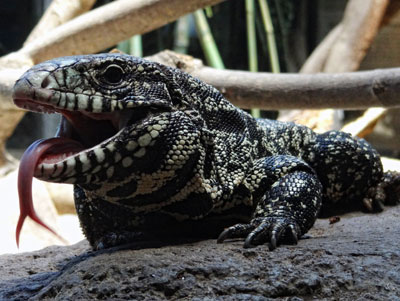
Tupinambis merianae, or the Argentinian Tegu (black and white) are the largest among tegus. They call them also as Argentinian giant tegus. They belong to the Teiid family. The ecological niche of the tegus is similar to that of monitor lizards. These tegus provide a fine example of convergent evolution.
Habitat
They are a terrestrial species found in tropical forests, savannahs and the semi arid deserts of Latin America.
Anatomy
When they are hatchlings, they possess an emerald green color from the tip of the snout to half of the neck with black marks. The emerald green color will give way to black after shedding, in two months. Adult males are larger than the females. At maturity, they measure around 3 feet long and continue to grow till they reach lengths of 4 to 4.5 feet. The females reach a maximum length of 3 feet. They possess beaded skin and linear stripes that run down the body. Their adult weight ranges from 2.5 to 7 Kilos.
As a Pet
These tegus make excellent pets. They tend to become attached to their keepers and are quite docile in nature. A very well cared pet can live for more than 20 years in captivity. If you don’t handle them regularly, they might exhibit aggressive behavior since they become less comfortable with you.
Housing
These big-sized tegus need large enclosures that are secure. You can keep juveniles in large aquariums with lids. Adults need much larger cages. The cage can be of 6x3x2 foot size. You should provide a hide at the temperature gradient’s one end. If you can keep the hide a little damp, it will help with shedding.
Substrate
Sice tegus love to burrow, you should provide a substrate that is absorbent and easy to clean. The preferred substrates are cypress mulch, eucalyptus mulch and orchid bark. Some, keepers just provide several layers of paper, It could prevent the pet’s digging instinct. You should avoid wood chips, corn cobs and gravel due to ingestion risk.
Heat and Light
You should maintain daytime temperatures between 80-85 F. The temperature at the basking spot should be 100-110 F. Cooler night time temperatures are okay. You can use heat mats and lamps. Please avoid hot rocks.
Captive diet
You can feed the tegus with crickets dusted with calcium and vitamin D3 supplements. You can offer them other insects for variety. You can feed the older ones with pinky and adult mice. You can add a variety of fruits and vegetables to the diet of the adult tegus. You can also give them eggs and caned dog food. You should feed them in a bowl or with tongs to avoid accidental bites.
Handling
In spite of their size, Argentinian tegus are surprisingly docile and tame. This will be more so if you handle them from a very early age.
Philippine Sailfin Dragon (Hydrosaurus Pustulatus)
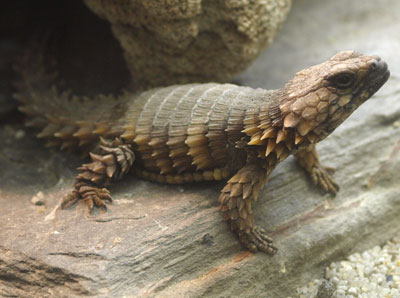
Armadillo lizards belong to the species Ouroborus Cataphractus. They are endemic to South Africa’s deserts. You can call them by many names which include girdled lizard, spiny-tailed lizard, golden armadillo and armadillo lizard.
Habitat
You can find the armadillo along the coasts of South Africa.
Anatomy
The girdled lizard is light or dark brown in color. The color of the underbelly is yellow with black patterns under the chin. They range from 7.5-9 cms in length.
From snout to vent, their maximum length can be 10.5 cms. Their bite force is so strong in the adults that they can break their own jaws.
As a Pet
This lizard is rather common as a pet. You can find them in pet stores and you can quite easily breed them in captivity. The lifespan is around 10 years or a little longer.
Food
The lizard feeds on invertebrates like spiders and insects. Crickets are the usual feed in captivity. In the wild their common prey are termites. They also eat smaller lizards and rodents.
Breeding
This lizard species are one of the few that do not lay eggs. They give birth to one or two babies. Unusually for lizards, they even feed their young.
Defensive Action
Armadillo lizards have a unique way of escaping from predators. The lizard takes its tail in the mouth and rolls into a ball when it feels threatened. The thick scales along its back and the spines in the tail protect the animal in this shape. This behavior, which is similar to that of the mammal Armadillo, gives it its name.
Marine Iguanas (Amblyrhynchus Cristatus)
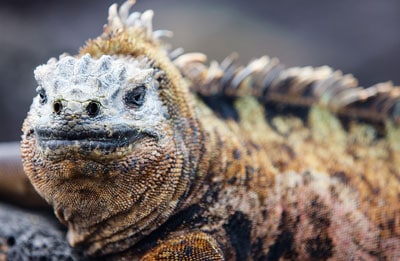
The marine iguanas are endemic to the Galapagos Islands. They have the unparalleled ability to live in the Ocean and forage for food there, according to it the status of a marine reptile. They can dive more than 9 meters into the sea. The extensive proliferation of the species has brought its presence in every Island that forms part of this archipelago. So we can also call them the Galapagos marine iguanas. They shift to the rocky terrain of the show shore to warm themselves from the relatively cold water. You can also spot them in the s mangrove beaches and the swamps.
Being ectothermic or cold blooded, these iguanas cannot spend much of their time in the water. They have to warm themselves, Till they do so, they cannot move effectively. This will make them vulnerable to predators.
Anatomy
The young marine iguanas possess light colored dorsal stripes in comparison with the adults. Some adults are gray and the color of the males change according to the season. The dark tones help the lizards to absorb heat rapidly and offset the cold of the water.
Adult males measure up to 1.7 meters length, while females are only 0.6 to 1 meter long. A Male can weigh all of 12 kilos.
The iguanas are not very agile on the land surface, but are attractive swimmers. The flat tail and dorsal fins help them to swim. Their claws are sharp and this allows them to get a good grip on the rocks even when the currents are very strong.
Diet
They consume Algae and Seaweed for their staple diets. They tear the algae from the rocks using their sharp teeth and flat snout. Their special nasal gland filters excess salt from their blood.
Breeding
Males amass large harems and they aggressively protect them from rivals. Fights do happen, but are usually harmless. They bob their heads in a challenge and if the rivals respond, they thrust their heads together until one backs away.
When the breeding season arrives, you will find that the females surrounds the males like a harem and the males will aggressively guard their territory against intruders. Fights are a common affair, but generally end up without harm to either side. During this altercation, the male will continue bobbing its head continuously to imply a threat perception and. If the opponent wants to respond, they will confront each other, head to head until one of them backs away in defeat.
During breeding season, adult males appear very colorful. The colors vary according to the habitats.
Minute Leaf Chameleon (Brookesia minima)
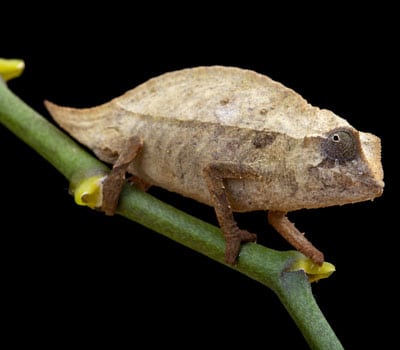
Minute leaf, dwarf chameleon, pygmy chameleons, pygmy leaf, leaf chameleon and the very small ground chameleon are all common species of Brookesia minima. Minute chameleons (leaf) are a very diminutive chameleon species very often confused as the smallest of the chameleons.
Anatomy
B. minima adult possesses a flattened head, orbital crest along with large, scaly triangular plates over the eyes. We can find granular projections in two rows along its backs. These specimens occasionally sport yellow stripes laterally over the dull grayish brown color of the body. The females are bigger – around 3.4 cm long – compared to the males. Males are also more slender. Males sport hemipenial bulges at the tails’ base. Many often consider them to be the smallest of all Chamaeleonidae, but you can find smaller species.
Diet
B. mimima belongs to the rain forests of its native island. They are very active as far as chameleons go. They love moving around in the lower branches and leaf litter of the rain forest. They are fairly aggressive towards each other. Their population in the wild is around one chameleon per square meter.
Breeding
There is not much information about these animals, but suffice it to say that a typical clutch has two eggs.
As a Pet
Captive breeding of the species reportedly, has not been successful. B. minima is rather territorial in nature. So you would do well to provide individual housing even for very young specimen. The terrarium or glass enclosure size should be at lest 16 “x16”x16”. They prefer to keep close to the ground, which makes the height of the enclosure, less important. The eggs of the B.minima are very tiny. They are difficult to locate. Breeders usually leave them in the enclosure till they hatch.
Leaf Nosed Lizard (Ceratophora tennentii)
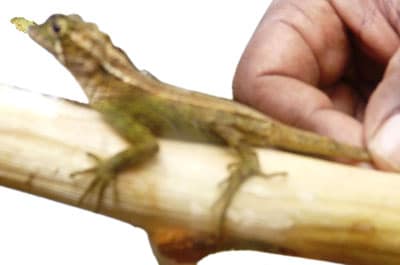
Leaf-nosed lizards belong to the species Ceratophora tennenti; they belong to the family Agamidae. They are endemic to Sri Lanka. We can find the leaf-nosed lizards in knuckles forests. The lizard is a real pro when it comes to blending with the surroundings. They have a leafy-looking protrusion near the front of the face. The lizard can also alter its color in tune with the environment. The lizard has not been able to escape from the man-made threats arising from logging, deforestation fires and the like. You can find the lizard’s name in the IUCN’s endangered list.
Anatomy
The leaf-nosed lizard is also goes by the names, horn-nosed lizard and the horn-lizard. It has an appendage on its nose that looks like a leaf; hence the name. The species can grow up to 8 inches including the tail. Ceratophora is its generic name. It literally means horn bearer. The males usually are greener than females. The color can change to reddish brown. The appendages on the noses of the females are shorter. These lizards are not very agile. They depend more on the coloration and the ability to blend with the environment rather than speed, to evade predators. Being diurnal, they are active only in daytime. There is not much information about this extraordinary creature.
Habitat
You can see them, usually in tropical cloud forests of the Knuckles Mountains of Sri Lanka. You can also spot them in other forest habitats.
Diet
The leaf lizards reportedly feed on insects and other small arthropods.
Breeding
Leaf-nosed lizards are egg-layers who reproduce sexually.

Having discovered a fondness for insects while pursuing her degree in Biology, Randi Jones was quite bugged to know that people usually dismissed these little creatures as “creepy-crawlies”.

